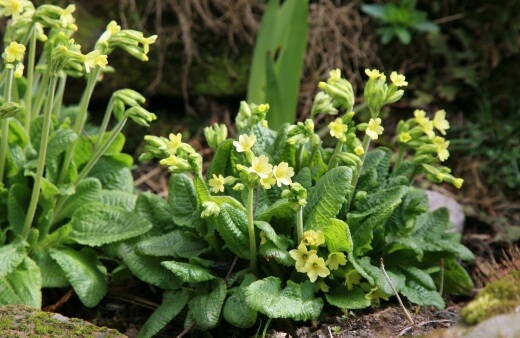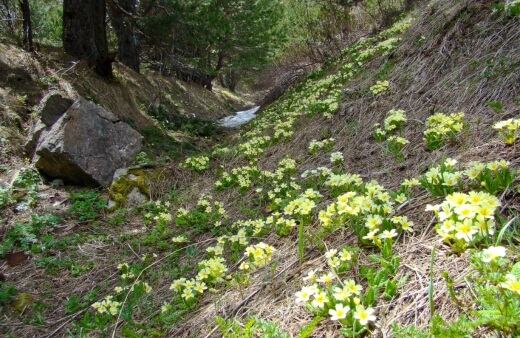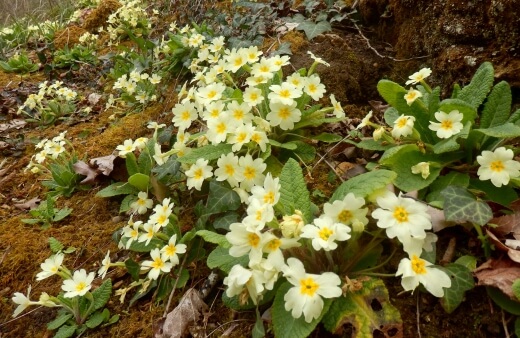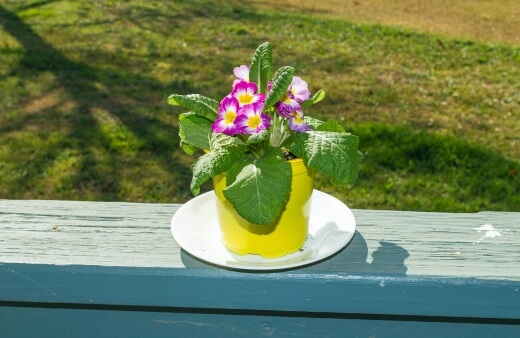Primroses are excitingly garish plants, available in every colour imaginable, often trimmed with gorgeously bright yellow tips. Their leaves spread out widely across the ground, producing a stunning carpet of textured greens which fade as quickly as they appear in later spring.
As well as their traditional beauty, primroses also help to solve one of the most complicated problems in the garden – finding bright colours for shady spaces. Follow our guide to grow your own primroses from seed, cuttings, or young plants.
More...

Family: | Primulaceae |
|---|---|
Genus: | Primula |
Species: | P. vulgaris |
Origin: | Western and southern Europe |
Common Names: | Common primrose, English primrose, Primrose |
Location: | Outdoor |
Type: | Perennial flowering plant |
Growth: | 10-20 cm tall, 30-40cm spread |
Sun requirements: | Shade or dappled shade |
Foliage Colour: | Green |
Flower Colour: | Various |
Flowering: | Late winter or early spring |
Fruit: | None |
Maintenance level: | Low |
Poisonous for pets: | Mild toxicity (nausea and vomiting) in cats and dogs |
Introducting Primroses

Primroses (Primula vulgaris) are one of the more basic forms of primulas, a wide genus of plants known for their bright colours and adaptability to different conditions. These perennial flowering plants are shallow rooted and spread from seed and their root systems, creating clumps in borders and occasionally popping up elsewhere in the garden as a gentle surprise in spring.
The flowers of Primula vulgaris are edible too, and while they have little flavour, they look incredible as a finishing decoration on iced cakes.
Natural Habitat of Primula vulgaris
They are native to Western Europe, but most commonly cultivated in Britain, where they are iconic to native woodlands, providing swathes of understory-planting around woodland edges where trees offer dappled shade, and just enough moisture for them to thrive.
How to Grow Primroses in Australia
As long as you don’t plant them in boggy conditions, or out in exposed conditions, you can’t really go wrong with primroses. Follow the simple guide below to grow your own vivid flowers this year.
Tip: Growing your own primroses is exceptionally simple, and because they’re such resilient plants, you can save a lot of money by simply being patient. We always buy our primroses when reductions start in late spring.
The potted primroses in garden centres are always reduced when they slow down flowering, but you can plant them out in the garden and get a full display the following year for a fraction of the price of those bought in winter or early spring.

Best Conditions for Planting Primroses
The easiest way to plant primroses is by starting with potted plants. Seeds provide the results in their second year, but potted primulas will flower vigorously when planted in a good, shaded, location on rich soil.
What Soil to Use
Neutral to slightly acidic soil is best from primroses, and they do benefit from a light mulch of organic material, either before planting, or each year after.
They are not particularly hungry plants but perform better on enriched soil. If you’ve got your own compost or leaf mould, primroses will really appreciate it, but otherwise, any peat-free compost from a garden centre will do the job.
Drainage
Primroses don’t like to sit in boggy conditions, but they can cope with it. Their natural conditions are in the moist shade of trees, where they share water with taller mature plants and rarely get waterlogged.
However, if your garden does get completely flooded in winter, primulas do tend to make surprising comebacks in spring when excess moisture has drained away.
Light & Temperature
Primroses need dappled shade. They will struggle in full sun, and their leaves can burn to a crisp in hot springs, so avoid exposed planting positions, and if you plant primroses in pots or containers, make sure they are protected from the afternoon sun.


Get Your Free Guide:
Master Growing Australian Natives eBook
A Must Have Complete Guide for Every Australian Garden
Get Your Free Guide:
Master Growing Australian Natives eBook
A Must Have Complete Guide for Every Australian Garden
How to Propagate Primrose
Primroses are best planted out as young plants, and they are really cheap to buy in bulk at the right time of year. But… They can be grown from seed, either in pots or directly outdoors, and dividing existing plants is a great way to double or even triple your stock of primroses each year.
Propagating Primrose from Seeds
Primroses can be sown outdoors in late spring, or autumn. In both cases they will develop and flower the following spring, but late spring sowings generally replicate natural conditions better.
To sow primroses outdoors, just rake over a shaded spot of soil, and sow them directly on the surface. Rake them in and water well, and leave them to do their thing. Next spring, you should be rewarded with a flush of young plants, which will perform even better in their second spring.
To sow primroses indoors, start in early autumn. Pop them in an airtight bag at the back of the fridge for two weeks (the cold period helps them to germinate), then sow two seeds into 8cm pots filled with compost.
Leave them somewhere bright, but away from direct light, and allow them to develop in their containers until spring.
Propagating Primrose from Division
Primroses are incredibly simple to divide, and don’t even need to be dug out of the ground, or re-potted to do it. All you need is a trowel and somewhere new to plant them.
Look for primroses growing in clumps together, and dig between two rosettes. Lift one rosette (or a cluster no more than half the size of the original clump) and plant it directly somewhere else in the garden.
The best time to divide primroses is just as they emerge from the soil in late winter. Check for small dimpled leaves bursting out of the soil (they look like a tiny, wrinkled lettuce when they first show in winter and are really easy to move).
How to Care for Primroses
Established primroses don’t take much care or attention, and will largely continue to flower year after year once they find a happy spot in the garden.

Mulching & Feeding Primroses
Primroses really do love to be mulched. You can mulch generously (1-2” over the top of primroses in spring, provided you mulch a few centimetres away from the emerging leaves. If you mulch over winter, you can mulch generally and they will find their own way through in spring.
Use leaf mould or garden compost from your own compost bin to provide natural and organic mulches for these woodland plants.
If you don’t have one yet, check out our reviews of the best compost bins for 2023.
Watering Primroses
In a reasonably moist, sheltered part of the garden, you don’t need to water primroses at all, but in pots and containers, primroses should be watered once a week in dry weather. They should not be left to dry out before flowering.
Deadheading Primroses
Deadheading primroses will stop them from going to seed, so it isn't advisable if you want to allow them to naturalise. For potted primroses, deadheading can support continued flowering, and adding a layer of mulch in late spring can even extend their flowering season into summer.
Possible Primrose Problems
Primroses are resilient plants, and once you’ve got them to flower in their first year, will generally remain pest and disease free in your garden forever.
Primrose Pests
Primroses suffer from so few pests that it’s barely worth mentioning, but if you do notice any defoliation or eaten leaves, it will usually be a result of mice or slugs.
Spring foliage can be damaged by birds and aphids too, but once primroses have become established they very rarely succumb to any pest problems.
Primrose Diseases
Primrose leaf spot and botrytis blight can damage primroses that are overwatered, especially if you have used infected plants to make your compost. Prevention of these diseases is largely about garden hygiene, and burning or disposing of any infected plant material in general waste, rather than garden waste bins.
Regularly cleaning tools will help to prevent the spread of these diseases which can rot leaves, stems, and roots.
As with any plant suffering from leaf spot or botrytis, you should remove the immediately infected areas immediately and burn them. Follow that with regular inspection of the rest of the plant to ensure that infection does not spread.
Primroses Frequently Asked Questions

Are primroses and primulas the same?
All primroses are primulas, but not all primulas are primroses. Primula is the wider genus of plants, including many common species, but common English primroses are a low-growing woodland variety that can offer vivid colour to shady spots of most gardens.
Do primroses come back every year?
Primroses come back every year provided they are in moist conditions and fed annually with organic compost like leaf mould to support base nutrient levels in the soil.
What month do primroses flower?
Primroses typically flower from July through to November in most parts of Australia. They follow cold spells and begin to sprout when the days start to lengthen after mid-winter.
What is a primrose flower good for?
Primrose leaves and flowers are used to treat anxiety, and their flowers have been used as a herbal remedy for insomnia for many years. Like most herbal medicine, scientific testing is not wide-ranging enough to prove conclusive.
Where do primroses grow best in Australia?
Primroses grow best in woodland borders, or beneath the dappled shade of overhanging shrubs. Not only do they like the shade, but they benefit from the falling leaves or deciduous trees and shrubs in borders.
When should you plant primroses?
You can plant primroses at any time of year, even when they are completely dormant and have no top growth showing, but it's best to plant young primroses in late winter or spring for maximum impact.
How many times a year do primroses bloom?
Primroses can flower several times throughout the year, but most commonly flower just once in spring. With deadheading and regular care (including summer mulching to shade the soil) primroses can flower well into summer.
Can you eat primroses?
Primrose flowers are edible, and their leaves are used as a medicinal herb. However, their flavour is minimal so they are best used as decoration in salads and baking.
If you are looking for edible flowers, check out our extensive list of the best edible flowers to grow in Australia.
Wrapping Up Our Primrose Growing Guide
Primroses are one of my favourite plants, and I firmly believe they should be planted in every garden in the country. OK, so they’re far from native, but there’s something quite magical about these woodland edge plants that captures the essence of early spring like nothing else quite can.
Growing your own primroses is super simple and highly rewarding. Even in warmer parts of Australia, if provided with enough shade and summer mulch, primroses can cope well as flower vigorously in the cooler months.
Published on April 5, 2023 by Maisie Blevins
Last Updated on February 23, 2024




